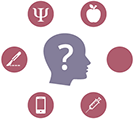Providing treatment as part of a fair test
Download a pdf of Providing treatment as part of a fair test
So what should happen when there is important uncertainty about the effects of new or old treatments
that have not been properly evaluated? An obvious answer is to follow the example of the doctor caring for his stroke patients, as we described above: address the uncertainty by offering inadequately assessed treatments only within the context of research that has been designed to find out more about both their wanted and unwanted effects.
A medical ethicist put it this way: ‘If we are uncertain about the relative intrinsic merits of any [different] treatments, then we cannot be certain about those merits in any given use of one of them – as in treating an individual patient. So it seems irrational and unethical to insist one way or another before completion of a suitable trial.
Thus the answer to the question, “What is the best treatment for the patient?” is: “The trial”. The trial is the treatment. Is this experimentation? Yes. But all we mean by that is choice under uncertainty, plus data collection. Does it matter that the choice is “random”? Logically, no. After all, what better mechanism is there for choice under uncertainty?’ [22]
Providing treatments as part of fair tests can help to make a profound difference to outcomes for patients. The story of childhood leukaemia provides a very dramatic example of this.
Until the 1960s, virtually every child with leukaemia died soon after the diagnosis had been made. Now about 85 children out of 100 survive. This has been achieved because most children with leukaemia have participated in randomized trials comparing the current standard treatment with a new variant of that treatment. [23] For most children with cancer, therefore, the best treatment option is chosen by participation in such trials.
If no such trial is available, at the very least the results of using new and untested treatments should be recorded in a standardized way – for example, by using a checklist of items including the laboratory or other tests that will be used to diagnose a condition and the tests that will be done to assess the impact of the treatment.
The plan of investigation could also be registered in a database, as should happen for clinical trials. By doing this, the results can contribute to the body of knowledge for the benefit of the patients receiving the untested treatment and patients everywhere. Huge sums of money have already been invested in healthcare IT systems, which could readily be used to capture this information for the benefit of patients and of the public. [24]
There will have to be changes if uncertainties about the effects of treatments are to be addressed more effectively and efficiently. We discuss some of these – particularly the greater involvement of patients – elsewhere. However, there is a particular issue – we touched on it above – that we want to emphasize here.
When there is insufficient information about the effects of a treatment, knowledge can be increased by ensuring that clinicians only offer it within the context of a formal evaluation until more is known about its value and possible disadvantages. Yet some prevailing attitudes, including systems of research regulation, actually discourage this risk-limiting approach.
The problem vexed a British paediatrician over 30 years ago when he pithily observed that he needed permission to give a treatment to half his patients (that is, to find out about its effects by giving half the patients the new treatment and half the existing treatment in a controlled comparison), but not if he wanted to give the same treatment to all of them as a standard prescription. [25]
This illogical double standard still pops up repeatedly and discourages clinicians who want to reduce uncertainties about the effects of their treatments. The overall effect is that health professionals can be deterred from generating knowledge from their experiences in treating patients. As the American sociologist Charles Bosk once remarked: ‘anything goes, as long as we promise not to learn from the experience’.
Being able to explain uncertainty clearly demands skills and a certain degree of humility on the part of doctors. Many feel uneasy when trying to explain to potential participants in a clinical trial that no one knows which treatment is best. But the public’s attitude has changed: arrogant doctors who ‘play God’ are increasingly given short shrift.
We need to focus on training doctors who are not ashamed to admit they are human and that they need the help and the participation of patients in research to provide more certainty about choices of treatments. The main stumbling block for many clinicians and patients is lack of familiarity with the features of fair tests of treatments, an issue we tackle next.
